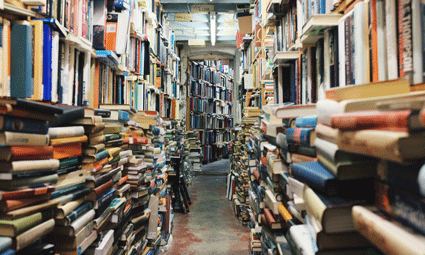The Center’s director explores why the digitalization of so many physical items in our lives results not only in less clutter but increased access.
______________________________
By Jeffrey Cole
Our job at the Center for the Digital Future is to track the expected and, more importantly, unexpected change that comes from digital technology. After 18 years of tracking digital impact, the unexpected change continues to arrive from the most interesting and surprising places.
 In this column, I want to track how digital has freed up an enormous amount of physical room in our lives. In the next column, I’ll look at how much money or spending capacity has been unlocked.
In this column, I want to track how digital has freed up an enormous amount of physical room in our lives. In the next column, I’ll look at how much money or spending capacity has been unlocked.
Digital technology has turned out to be the best “de-clutterer” in history. While digital may do little to cure the deep-seated causes of hoarding, it does go a long way to avoiding George Carlin’s dilemma of always needing a bigger place for “our stuff.” As Carlin brilliantly observed long before digital, when we accumulate too much stuff we don’t get rid of it: instead we find a bigger place so we can get more stuff. Storage companies have built a massive industry from our getting and keeping more stuff.
The first big dent in this modern issue is digital technology.
Many years later, I look back fondly on when I graduated college and everything I owned (except for the stuff I left at my parents’ house) fit in my VW Beetle. Today, I feel like I would need an army of cleaners to sort through my house and a fleet of moving vans to move it somewhere else.
_________________________________________________________________________________________________
The advantages of digital technology (as well as some of the disadvantages) are obvious to all of us. They allow us to communicate around the world immediately, at no cost, so we can stay constantly connected to the important people in our lives. Digital has changed the way we work and buy, and it has (mostly) improved our lives in countless other ways.
_________________________________________________________________________________________________
My generation may be the last one for which too much stuff is a problem because, in short, much of the stuff I gathered and treasured is now available as digital stuff. There may still be massive accumulation and clutter, but it exists in the cloud. Some examples I recently have seen in my own life:
1. Photographs and videos. My life is full of boxes of photographs, photo albums and prints still in the folders that came from film processers. (In the next column I will estimate how much money I spent to accumulate these physical photographs.) Despite all the boxes and physical space the photos take in my garage and closets, there is no organization to the photos and no easy way to display them.
Things are just as bad with the camcorder videos I have been taking for the past 38 years. Three rows of bookshelves are dedicated to these videos and another two to the Super8 films my parents took when I was a child. Not only do these photos and video take up a lot of physical space in my house, they also require projectors, screens, or other equipment that have to be maintained (which is harder and harder to do each year) and also take up space. All these visual media are subject to fading from sunlight and heat.
Over the past ten years, I have taken far more photos and video than ever before, but they took up little and now no space at all. The fact that a camera is a constant presence in our lives through our smartphones ensures we take more pictures and video. Ten years ago, I began storing all these pictures and videos on memory cards that took up almost no space. Now, I save them all to the cloud where they literally take up no space. The cloud is also safer and, I hope, not subject to damage. Everything about digital improves the situation with film and video: it is cheaper, takes no space, is easier to organize and share, and the best photo albums ever created are smartphones and iPads.
2. Books. I was a history major: I have thousands of books and wish I could have more. Twenty years ago, I had more books than could fit on the shelves in my home and office. Yet I kept buying more. I have thousands of dollars invested in bookshelves. Books were taking over my life.
If I were starting college today, I would buy as many books as possible electronically for tablets or Kindles. I would still accumulate thousands of books, but I would only need to own physical copies of art or photography books that are beautiful to look at. I could have many more books, would spend far less money, and I’d be able to easily take them with me when I move or even just when I go on vacation. These books would exist in my home, office, hotel room… anywhere I go.
3. CDs. I own 400 CDs. Not only am I the last generation that will ever own that many CDs (some of my friends have thousands), but today’s teens are also the last generation who will ever own any CDs at all. Our work shows the average teen owns four to eight CDs. My 400 CDs take up a tremendous amount of bookshelf space (not to mention the hundreds of LPs that I still can’t manage to part with).
Sadly, with all of the money I spent on my music and the space it takes, I only own a small percentage of the music I love. Steve Jobs solved my space problem when he convinced the reluctant music companies to sell their songs individually through downloading. As of 2003, I only had to buy the songs I wanted (not twelve songs on a CD). Like digital photographs, downloaded songs take virtually no space. Streaming has made the situation even better, as I now have access to all the music I ever wanted, don’t have to buy anything, and the music now takes up no space.
4. VHS cassettes and DVDs. I don’t want to count the movies I have bought, but they take up four full bookcases. Only too late did I realize that there are only 10-15 movies I will ever watch once or more, so most of the DVDs on my shelves are still in their plastic wrap. Today, Amazon, Netflix, Hulu, and a few other services give me access to the whole history of film and television, much of it free or for a small fee through streaming. I get everything, and it takes no space. Streaming is so easy that, even if I own physical copies of a film or music, it is just easier to watch or listen to it that way.
5. Papers and receipts. My garage is also full of boxes of papers, receipts, and other physical records. If I ever needed to find something it would be a hopeless task. If it were an emergency to find something, then it would be a weekend project. And with paper, there is no central way to organize all that information.
Three years ago, I bought a scanner directly connected to Evernote. Now, I scan all my papers, receipts, and other paper items into the scanner, get rid of the paper, and can easily search any document by key word. It has made my desk, house, and mind far clearer and less cluttered, and I can find whatever I need in an instant.
The advantages of digital technology (as well as some of the disadvantages) are obvious to all of us. They allow us to communicate around the world immediately, at no cost, so we can stay constantly connected to the important people in our lives. Digital has changed the way we work and buy, and it has (mostly) improved our lives in countless other ways.
Only recently have I realized how much I have reduced stuff and clutter over the past ten years. If I were graduating college today, I would have access to far more information and media than any generation in human history, but it would be neatly organized and searchable, and it would take up no space.
____________

Jeffrey Cole is the founder and director of The Center for the Digital Future at USC Annenberg.
See all columns from the Center.
May 9, 2018

